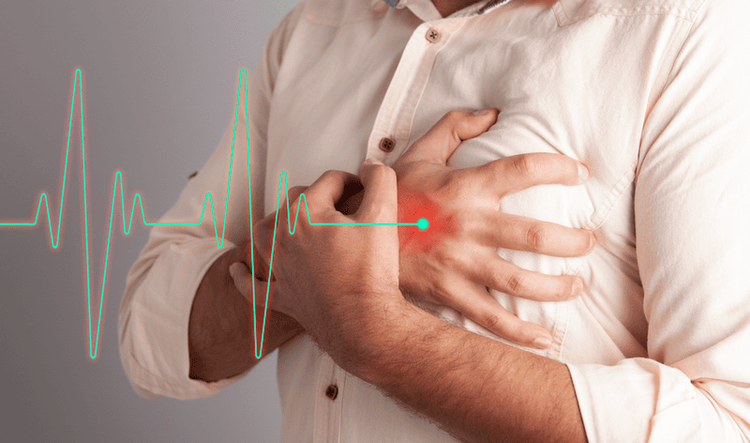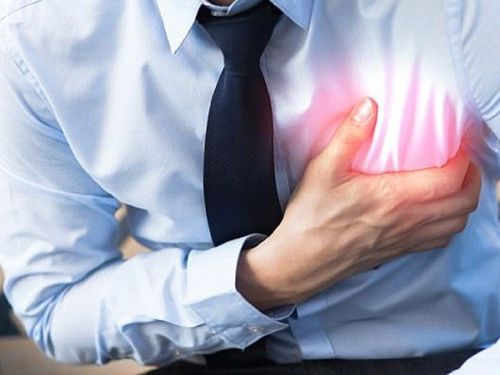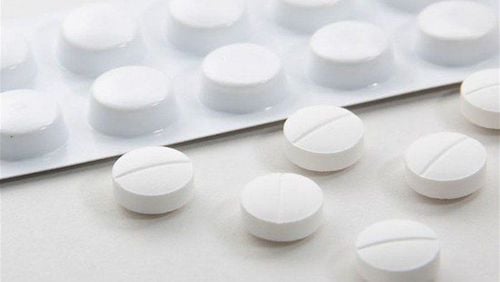This is an automatically translated article.
The article was professionally consulted by Dr. Le Duc Hiep - Internal Medicine and Cardiovascular Interventionist - Cardiovascular Center - Vinmec Times City International HospitalAngina is a type of chest pain caused by reduced blood flow to the heart, the pain is often described as a feeling of squeezing, heaviness, or just discomfort in the chest. Some people with angina symptoms report a feeling of angina like a hand is pressing on their chest or a heavy object is pressing on their chest.
1. Causes of angina attacks
In clinical practice, chest pain with symptoms described as heaviness, suffocation, appearing on exertion is one of the signs suggestive of coronary heart disease. In addition, angina is also a manifestation of diseases other than cardiovascular diseases such as diseases of the digestive system or other diseases of the lungs. There are generally 2 types of angina, stable angina and unstable angina. Stable angina is the pain that occurs with exertion, these cases are usually the patients themselves have narrow coronary arteries, the blood supply to the heart is low, so when exertion, the oxygen demand of the heart increases, so the pain occurs. . Meanwhile, unstable angina is caused by atherosclerotic plaques causing severe narrowing or cracking or rupture causing thrombosis that partially or completely occlude the coronary artery. Angina comes on suddenly, even without exertion. This is a chest pain that requires emergency treatment.
In fact, the risk factors for angina due to cardiovascular disease are explained as follows: The heart is fed by a system of arteries called the coronary artery system, when the coronary arteries are narrowed, blocked, leading to blood pressure. Poor blood supply to the heart, then the patient will have angina attacks.
There are many causes of angina with different forms of disease, of which the most dangerous is myocardial infarction (occurs when a blood clot partially or completely blocks an artery, preventing blood from reaching the heart muscle). In addition, dissection of the inner layer of the aorta can also cause coronary ischemia, which is considered a serious condition requiring emergency surgery. The pain in this case is usually very severe, comes on suddenly and feels like a tear in the back or between the shoulder blades.
In addition, there are many episodes of acute angina that are not caused by coronary artery disease such as pulmonary embolism, hypertension, aortic regurgitation, arrhythmia, extrasystoles (irregular rhythms) ) or aortic aneurysm. Angina caused by coronary artery disease often has pain behind the sternum, the nature of the pain is tight, some people have a feeling of pressure, the pain lasts a few seconds to a few minutes. The direction of pain is radiating to the inner face of the arm, forearm, down to the fingers, or the pain spreads to the chin or back, sometimes down, this makes it easy for patients to mistake pain. stomach .

Tình trạng rối loạn nhịp tim có thể gây ra các cơn đau thắt ngực
On the other hand, the cause of angina may be due to the effects of the digestive system such as esophageal muscle spasm, esophagitis or some diseases related to the stomach and intestines. Gastroesophageal reflux is also a risk factor for angina. Patients in these cases will feel uncomfortable, sweaty.
Other risk factors for angina due to lung disease include conditions such as pneumonia, pleurisy, pneumothorax, or pulmonary embolism caused by a blood clot blocking blood flow to lung tissue, often occurs in people at high risk for recent surgery.
Other causes of angina may be encountered such as skin, muscles, bones, tendons, soft tissues and cartilage of the chest wall being inflamed or traumatized, it is necessary to ask the patient's history of activities and collisions. Psychological disorders such as depression and panic attacks may be accompanied by chest pain, tachycardia, rapid breathing, and shortness of breath.
2. Ways to prevent angina attacks from occurring
In the past, angina usually only occurred in subjects with many risk factors such as the elderly with coronary artery disease, family members with the disease, especially in people with a poor lifestyle. healthy, sedentary, overweight and obese people, high blood pressure, diabetes, smoking,... Many people have diseases but are still healthy, absolutely no signs of the disease until it occurs. diagnosed with myocardial infarction. In recent years, coronary artery disease tends to be younger, appearing even in young people and tends to increase. Many young people with coronary artery disease at an early age (28-29 years old) have had angina attacks and myocardial infarctions. Most of these people have a high cardiovascular risk such as a history of smoking, dyslipidemia, obesity,...
Angina attacks are completely preventable by improving daily living habits, changing bad habits and maintaining good habits, in addition to combining drugs in certain cases. was diagnosed with coronary artery disease. Each person should spend at least 30 minutes a day to practice exercise such as walking, gardening, yoga, gym, ... so that all parts of the body are active.
Each person's weight also needs to be paid attention to, failure to control weight leads to being too fat or too thin, this situation going on for a long time will have a negative impact on health. Many studies have shown that overweight and obesity are among the typical risk factors for cardiovascular diseases. Depending on the height of each person, there is a reasonable weight for the body. To assess the status of overweight, obesity or undernutrition in adults, the World Health Organization (WHO) has introduced the BMI of Asians to assess the status of undernutrition, normal and overweight. obesity in each person. BMI is calculated as the ratio between a person's weight and the square of their height. For example, a person with a BMI of 19 is considered normal and a BMI of 35 is considered to be class II obesity.

Khám sức khỏe tim mạch định kỳ giúp phát hiện sớm bệnh lý tim mạch
For people with related diseases such as diabetes, hypertension, dyslipidemia, obesity,... it is necessary to adhere to treatment measures such as using drugs and a reasonable diet. . For patients who have ever had a heart attack, it is necessary to take the full range of medications every day as prescribed by the doctor. These drugs help prevent other heart attacks and reduce your chances of having a stroke or dying.
It is necessary to change healthy living habits and activities such as not smoking and drinking. Men should not drink more than 21 units per day and no more than 4 units on the same day. Women should drink no more than 14 units of alcohol per week and no more than 3 units of alcohol per day. Pregnant women and women who want to become pregnant should not use alcohol at all. In particular, absolutely do not use stimulants such as drugs. In addition, sleep and rest time should also be taken care of, limiting staying up late and spending too much time at work.
In particular, to protect their own health, each person should practice the habit of periodic heart health check-ups at reputable medical facilities. Currently, Cardiovascular Center - Vinmec International General Hospital is one of the leading centers in the country for examination, diagnosis, screening and treatment of cardiovascular diseases. With the convergence of a team of experienced and reputable experts in the field of surgery, internal medicine, interventional cardiac catheterization and the application of advanced techniques in the diagnosis and treatment of diseases. Cardiovascular management, along with a system of modern equipment, on par with the most prestigious hospitals in the world such as: 3 Tesla MRI (Siemens), 640 CT machine (Toshiba), other equipment Advanced endoscope EVIS EXERA III (Olympus Japan), Avace advanced anesthesia system, Hybrid operating room according to international standards... The Cardiovascular Center at Vinmec International General Hospital has achieved many successes. work and gain the trust of a large number of patients.
Please dial HOTLINE for more information or register for an appointment HERE. Download MyVinmec app to make appointments faster and to manage your bookings easily.













